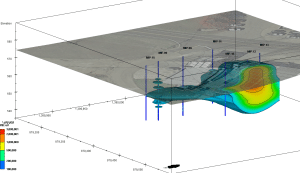 Contributed by Jacob Pongetti, Staff Scientist, PPM Consultants
Contributed by Jacob Pongetti, Staff Scientist, PPM Consultants
High-resolution site characterization (HRSC) is a set of strategies, techniques, and technologies that can be used to get a real-time look at subsurface conditions. Real-time data allows for HRSC activities to be scaled up or down depending on the data as it is produced. Generally, when we find ourselves assessing a site with possible subsurface soil or groundwater contamination the first move is usually grabbing a Geoprobe, collecting soil samples, installing wells, followed by collecting groundwater samples. While soil and groundwater samples are a tried and true method to generate dependable quantitative data for contamination; a lot of time goes by between sampling, laboratory work, and reporting. If contamination is found during the initial investigation, many times, the following steps involves returning to the site to install more monitoring wells to collect more samples. The additional wells and sampling are all in an attempt to “chase” the plume of contamination with the hopes that each attempt will be the last and clean samples will be produced from the newest wells. Thus, delineating the horizontal extent of the plume. Not only is this inconvenient and can be costly, having a site accurately characterized more quickly would inform whether neighboring sites could be impacted in one event. With HRSC techniques these additional mobilizations and sampling events can be drastically reduced.

Figure 1- 3D Visualization of Detected Volatiles Beneath a Site (Dakota Technologies Inc.)
HRSC uses a range of different tools to get a higher definition (higher resolution) picture of what’s going on beneath a site in real-time. These tools can be switched out in the field with a more suitable tool if/when need be. I have project experience with a few of the technologies; Laser Induced Fluorescence (LIF) [specifically the Ultra-Violet Optical Screening Tool (UVOST)], and Membrane Interface Probe (MIP). Both UVOST and MIP can be combined with hydraulic profiling (HP) and electric conductivity (EC). Entire articles can be written about each of these tools and their applications, I will attempt to keep this brief. The UVOST, MIP, and the associated HP tools can be used via direct push technology (a Geoprobe©), each of which collect real-time data as they are advanced into the subsurface.
LIF / UVOST
The UVOST can be used to detect the presence of free phase product in the subsurface. Polynuclear aromatic hydrocarbon (PAH) compounds, commonly found in petroleum products, exhibit fluorescence when exposed to the ultraviolet laser in the UVOST. In other words, the PAHs basically glow when exposed to the UVOST laser. The light emitted by the “glowing” PAHs is detected by the UVOST sensor. The unique waveform of the emitted light can be used to help identify the type of free phase product (gasoline, kerosene, ect..) in the subsurface.

Figure 2 UVOST Waveform Example, (Dakota Technologies, Inc.)
MIP
The MIP can be used to detect dissolved groundwater contamination or absorbed soil contamination within the subsurface. The MIP tool heats up the surrounding subsurface as it is advanced into the ground. As the surrounding subsurface, soil or groundwater, is heated volatile organic compounds (VOC) are released. The VOCs are captured by the MIP and transported through tubing, up the to a detector. Multiple types of detectors can be used with the MIP, to name a few; photo-ionization (PID), flame ionization (FID), electron capture (ECD), halogen specific (XSD). The MIP system can be used to generate a real-time log of detected VOC concentrations in soil and groundwater as the tool is advanced into the subsurface.
Hydraulic Profiling Tool
HPT technology can come included with UVOST and MIP tools. The HPT is used by injecting water down the drilling barrels and into the subsurface from the tool. The flow and pressure of the water is measured in real-time during the drilling process. The electrical conductivity is also measured with the HPT. The hydraulic conductivity can be calculated and logged along side the UVOST or MIP data. The electrical conductivity lends an idea of the subsurface grain size, which is an important factor in subsurface conductivity and permeability. Hydraulic conductivity is useful for measuring areas of high permeability and aids in the understanding of how contaminants/groundwater flow thorough the subsurface.

Figure 3- MIP/HPT example log (Dakota Technologies Inc.)
The scalability of the field work from the real time data generated by HRSC is one of the areas that make this technology shine. If it turns out a site is less contaminated than expected the HRSC activities can be scaled back based on the lack of contamination found. The inverse is also true, if a site is found to have a good bit of contamination the HRSC activities can be scaled up to account for the data as it is generated. Once a site is fully characterized HRSC can give a good idea of the best depths and locations to install wells to collect groundwater samples that reflect the best representation of the subsurface conditions.
If you have a remediation site that is having a tough time reaching cleanup standards sufficient to reach a no further action or perhaps your site is frustrating you with lack of delineation (one more well here, one more well there, etc.), then maybe its time to consider HRSC as a way to expedite site characterization or better yet closure! If you want to discuss the application of HRSC at your site, please feel free to reach out to me at 601-956-8233.

